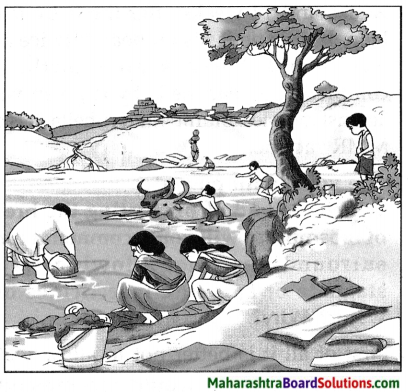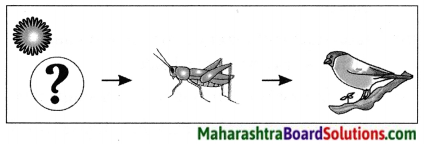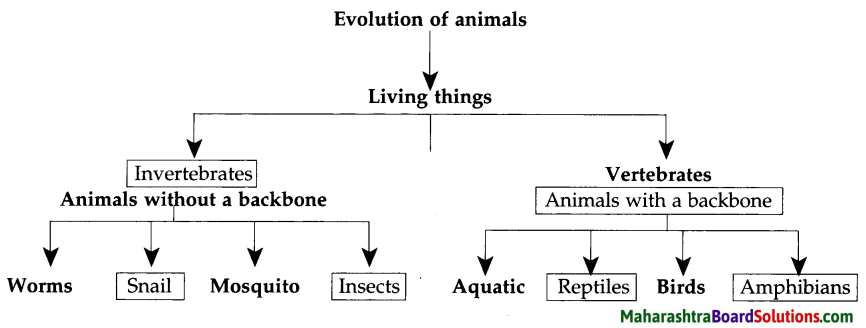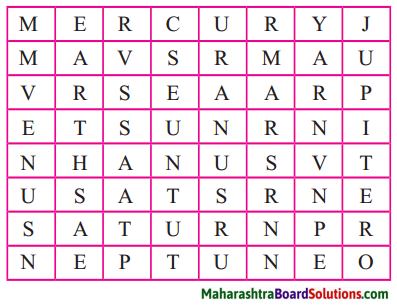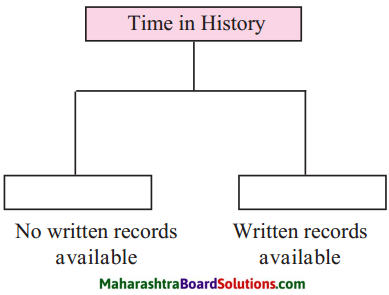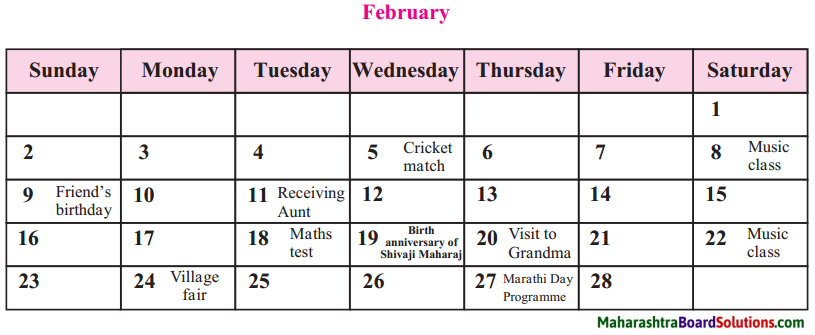Balbharti Maharashtra State Board Class 5 Environmental Studies Solutions Chapter 25 Community Health and Hygiene Notes, Textbook Exercise Important Questions and Answers.
Maharashtra State Board Class 5 EVS Solutions Part 1 Chapter 25 Community Health and Hygiene
5th Std EVS 1 Digest Chapter 25 Community Health and Hygiene Textbook Questions and Answers
1. Fill in the blank.
Question a.
A healthy and wholesome life leads to feelings of …………….. .
Answer:
A healthy and wholesome life leads to a feeling of friendship.
Question b.
Constant presence of tobacco in the digestive organs can lead to cancer of ………….. .
Answer:
Constant presence of tobacco in the digestive organs can lead to cancer of (any) digestive organs.
![]()
Question c.
…………… leads to diseases of the liver, intestines and urinary bladder
Answer:
Alcoholism leads to diseases of the liver, intestines and urinary bladder
Question d.
The most important factor in the country’s progress and development are its ……………. .
Answer:
The most important factor in the country’s progress and development are its people.
Question e.
Good community ………… can be achieved through habits of hygiene and good health.
Answer:
Good community health and hygiene can be achieved through habits of hygiene and good health.
2. True or false? Correct the wrong statement.
Question a.
Pollution, squalor, epidemics, addictions, and insect-borne diseases are all beneficial for community health.
1. True
2. False
Answer:
Pollution, squalor. epidemics. addictions and insect-borne diseases are all threats to the community
![]()
Question b.
There is a ban on spitting in public places.
1. True
2. False
Answer:
1. True.
Question c.
A nutritious diet, personal hygiene, exercise and pursuit of hobbies lead to excellent health.
1. True
2. False
Answer:
1. True
Question d.
We cannot live a wholesome life if we take care of our health.
1. True
2. False
Answer:
We can live a wholesome life if we take care of our health
3. Answer the following question.
Question a.
How can you achieve excellent health?
Answer:
Nutritious food. personal cleanliness. exercise and pursuit of hobbies leads to achievement of excellent health.
![]()
Question b.
What factors are a threat to community health?
Answer:
Pollution, squalor, epidemics of infectious diseases. addiction, insect-borne diseases, malnutrition are the factors that cause a threat to community health.
Question c.
What are the ill effects of chewing tobacco?
Answer:
- If tobacco is consumed, there are ulcers in the mouth. Ulcers develop into bigger wounds and they are later turned into tumours.
- Oral cancer, i.e. cancer of the mouth may be formed.
- Tobacco entering into the digestive system cause cancer of any of the digestive organs. It also leads to various complaints of the digestive system.
- A person with cancer has to undergo painful treatment. It can lead to death.
Question d.
What are the ill effects of alcoholism?
Answer:
- Alcohol acts on the brain of a person. Person becomes drowsy and confused.
- Alcohol makes a person lose control over one’s actions.
- Alcohol causes diseases of the liver, intestines and kidney, and urinary bladder.
![]()
Use your brain power
Question 1.
What bad habits will you guard against while trying to achieve your aim or interest in life?
Answer:
Do it yourself
Activity :
Question 1.
Write and present a short play on preventing addictions in society.
Environmental Studies Part 1 Standard 5th Solutions Chapter 25 Community Health and Hygiene Additional Important Questions and Answers
Fill in the blank with the correct answers from the option given below:
Question 1.
Pollution, squalor, epidemics of infectious diseases and insect borne diseases, addictions are all …………………. to community health.
(a) encouragement
(b) threats
(c) addictions
Answer:
(b) threats
![]()
Question 2.
It is a ………………… offence to spit in public places.
(a) legal
(b) illegal
(c) criminal
Answer:
(a) legal
Question 3.
If we take care of our health it is possible to lead a ……………… life.
(a) happy
(b) wholesome
(c) comfortable
Answer:
(a) happy
Question 4.
Cigarettes, bidis, masheri are …………… products.
(a) factory
(b) modern
(c) tobacco
Answer:
(c) tobacco
Question 5.
An entire family is destroyed due to …………………. of alcohol.
(a) addiction
(b) consumption
(c) solution
Answer:
(a) addiction
![]()
Question 6.
Addiction of tobacco can cause diseases like ………….
(a) tuberculosis
(b) cancer
(c) malaria
Answer:
(b) cancer
Question 7.
We must make ………….. to ensure good health for all.
(a) efforts
(b) pollution
(c) ugliness
Answer:
(a) efforts
Question 8.
To nurture community health is to ………… the general public from disease.
(a) avoid
(b) protect
(c) encourage
Answer:
(b) protect
Question 9.
People are urged in every possible way to keep their ………………. clean.
(a) surroundings
(b) body
(c) mind
Answer:
(a) surroundings
![]()
Question 10.
If we take care of our health, it is possible for us to lead a ……………… life.
(a) complete
(b) incomplete
(c) wholesome
Answer:
(c) wholesome
Question 11.
We see many people …………. tobacco in different ways.
(a) consuming
(b) destroying
(c) shunning
Answer:
(a) consuming
Question 12.
Drinking alcohol has …………… effects on the body.
(a) good
(b) bad
(c) adverse
Answer:
(c) adverse
![]()
Question 13.
Addiction to alcohol is called ………….. .
(a) fanatism
(b) alcoholism
(c) lunatism
Answer:
(b) alcoholism
Question 14.
……………. makes a person drowsy and confused.
(a) Alcohol
(b) Milk
(c) Coffee
Answer:
(a) Alcohol
Question 15.
………………….. causes diseases of the liver, intestines and urinary bladder.
(a) Fanatism
(b) Alcoholism
(c) Socialism
Answer:
(b) Alcoholism
Question 16.
Addiction to tobacco or alcohol are both very ……… habits.
(a) good
(b) bad
(c) ugly
Answer:
(b) bad
![]()
Question 17.
Never be ………… about health.
(a) negative
(b) assertive
(c) negligent
Answer:
(c) negligent
Question 18.
The family of an addict gets deprived of health and happiness is …………
(a) ruined
(b) built
(c) restored
Answer:
(a) ruined
Question 19.
Tobacco, drugs and alcohol produce a state of …………… .
(a) peace
(b) aggression
(c) intoxication
Answer:
(c) intoxication
Question 20.
Learn to say ………… firmly in order to avoid bad habits.
(a) Yeas
(b) No
(c) OK
Answer:
(b) No
![]()
From the actions given below, mark those that are harmful with a cross (✗) and healthy with a (✓) marks:
Question 1.
- Burning of tyres. [ ]
- Spitting anywhere on the road. [ ]
- Using public toilets [ ]
- Looking after domestic animals [ ]
- Following doctor’s instructions in cases of infectious diseases [ ]
- Washing your hands before a meal or snack. [ ]
- Throwing the garbage from your house on to the road. [ ]
Answer:
- Burning of tyres. [✗]
- Spitting anywhere on the road. [ ✗]
- Using public toilets [✓]
- Looking after domestic animals [✓]
- Following doctor’s instructions in cases of infectious diseases [✓]
- Washing your hands before a meal or snack. [✓]
- Throwing the garbage from your house on to the road. [✗]
Answer in one sentence:
Question 1.
What leads to good health?
Answer:
Nutritious food, personal hygiene, exercise and pursuit of hobbies lead to excellent health and good personal development.
![]()
Question 2.
How is mass media used to ensure community health?
Answer:
Mass media are used under community welfare programmes to educate people about issues such as taking care of drinking water and food.
Question 3.
How can we lead a wholesome life?
Answer:
If we take care of our health, it is possible for us to lead a wholesome life.
Question 4.
What happens when people of a society live a healthy and wholesome life?
Answer:
If people of a society live a healthy and wholesome life, social tensions also decrease and feelings of friendship can be nurtured.
Question 5.
What is addiction?
Answer:
At first, a person may consume drugs, alcohol or tobacco casually, but later he becomes dependent and cannot give up the habit. This stage is called addiction.
![]()
Question 6.
What happens to people when they are tobacco addicts?
Answer:
When people develop this habit, they become restless if they do not get tobacco. They are not able to pay attention to anything else as they have to have tobacco in their mouth at all times.
Question 7.
Why should we stay away from drugs, tobacco and alcohol?
Answer:
Addiction to drugs, alcohol or tobacco eventually kills the person. So everyone should be aware of the ill-effects of these addictions and strictly stay away from them.
Question 8.
How can we help an addict?
Answer:
An addict should be given the help of counsellors or doctors immediately to rid the person of the habit.
Question 9.
What is the only solution to stay away from bad habits?
Answer:
Learning to say ‘NO! firmly is the best way to stay away from bad habits.
![]()
Give reasons:
Question 1.
Burning tyres is not good.
Answer:
Tyres are made of rubber. When rubber burns it gives out many gases which are poisonous. These gases spread in the air and when inhales these gases affect the health of the people. Burning tyres also causes pollution of air. This will also affect birds and animals. Hence it is not good to burn tyres.
Question 2.
One should not spit on the road.
Answer:
Spitting on the road spreads infectious diseases if the spit is of a person already suffering from a disease. The spit dries up and it flies in the air and when we inhale this air we get the disease. Hence spitting on the road is not good.
![]()
Question 3.
One should not throw garbage on the road.
Answer:
Garbage thrown on the road decays and many flies sit on this. Even water gets stagnated due to garbage and mosquitoes breed there. Decaying garbage emits a foul smell and makes the place dirty. Hence this can affect the people’s health.
Question 4.
State whether true or false? Correct the wrong statements:
- Alcoholism causes diseases of liver, intestines, and urinary bladder.
- Eating mawa, pan masala are good for health.
- Community welfare programmes educate people about safe drinking water and food.
- Ban on smoking in public places helps in preventing the bad effects of passive smoking
Answer:
- True
- False. Eating pan masala is bad for health.
- True
- True
Some important factors that are harmful for community health are mentioned below. Some suggested remedies are mentioned in the next box. Add other ill effects and remedies to the respective boxes.
Question 1.

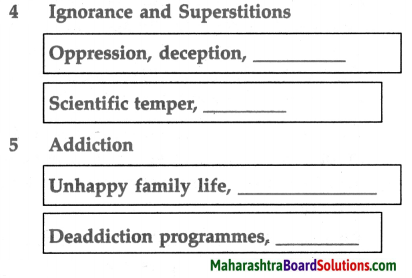
Answer:
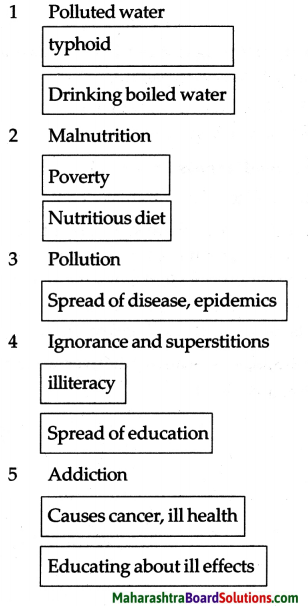
What’s the solution?
Question 1.
You have seen one of your friend’s brother smoking and drinking alcohol and he is slowly becoming addicted.
Answer:
If you see your friend’s, brothers becoming addicted with smoking and drinking alcohol, you should tell this to his parents. Then your friend’s, brother should be taken to a doctor or councellor to rid him of the habit. The family members and friend should support him and help him to give up the habit. Once he is rid of the habit, he should engage himself in some sports or other hobbies.
Question 2.
There is a slum area is your locality where there is lot of filth, dirt and people are living in squalor.
Answer:
People should be educated about the need to maintain hyginic conditions. The students can plan an awareness drive and do street plays and people should be educated about how they should keep their surroundings clean.
![]() +
+
Glossary :
- malnutrition – faulty nutrition due to inadequate or unblanced intake of nutrients
- envy – a feeling of discontent aroused by someone’s qualities etc.
- tuberculosis – a communicable disease that affects the • lungs caused by tubercle bacillus.
- epidemic – an outbreak of disease affecting a large population
- infectious – communicable by infection
- wholesome – promoting healthy body
- restless – showing unrest of mind.
- passive smoking – involuntary inhalations of tobacco smoke by a nonsmoker,
- remedies – treatment that relieves or cures a disease.
